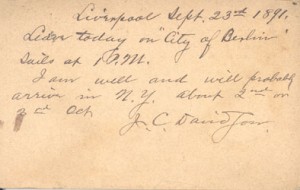One day when I walked into the Archives, I was confronted with several boxes full of letters from the mid 1800s until 1913. Some of the letters had been neatly placed in binders but most were still in their original envelopes, and none of them was in any real sort of order.
The letters were donated by Betsy Sherman Duls in memory of her mother Elizabeth Bradfield Sherman, whose great-great-great uncle may have helped found Davidson College. After working in archives for more than three months, I was to process my very first manuscript collection.
The college Archivist Jan Blodgett explained my task: organize the letters in whatever way I found easiest and turn them into an archival collection. I thought it would be a pretty easy task until I began looking through the letters; most of them were personal letters between family members who wrote to each other three to four times a week, and they usually did not state their whole name or how they were related to the addressee. On top of the family letters, there were quite a few business letters and bills of service to various members of the family.
 I began by going through each of the letters and taking notes to see who I thought was a member of the family, a family friend, or someone with whom the family did business. After going through most of the letters, I was able to come up with a definite family structure: Joseph M. Davidson, the brother of William L. Davidson and Robert (Robin) F. Davidson, married Mary Caldwell. Their children were Harold L. Davidson, E. Wilmer Davidson, John Caldwell Davidson (who married Julia Haacks), Sara Josephine Davidson (addressed as Josephine, she later married Tom Mallard), Bessie Davidson, Eloise Davidson, and Leila Davidson (who married Charles Hansell). Some close family friends were Brother Elzear and E.A. Osborne.
I began by going through each of the letters and taking notes to see who I thought was a member of the family, a family friend, or someone with whom the family did business. After going through most of the letters, I was able to come up with a definite family structure: Joseph M. Davidson, the brother of William L. Davidson and Robert (Robin) F. Davidson, married Mary Caldwell. Their children were Harold L. Davidson, E. Wilmer Davidson, John Caldwell Davidson (who married Julia Haacks), Sara Josephine Davidson (addressed as Josephine, she later married Tom Mallard), Bessie Davidson, Eloise Davidson, and Leila Davidson (who married Charles Hansell). Some close family friends were Brother Elzear and E.A. Osborne.
Initially I was challenged by the fact that the letters were mostly handwritten, and that many members of the family liked to write in a “cross hatch” way. The handwriting, however, proved to be a wonderful way to determine who had sent the letters. Still, I was very grateful to see that Harry, John, and Wilmer learned to type in the early 1900s!
 It was also fortunate that so many of the letters were dated, which is sometimes rare to see in the Archives. So while I could not always narrow down the addressee (often Mary would address her letters “Dear Son”), I now had a way to organize the letters: alphabetically by sender, and then chronologically by date.
It was also fortunate that so many of the letters were dated, which is sometimes rare to see in the Archives. So while I could not always narrow down the addressee (often Mary would address her letters “Dear Son”), I now had a way to organize the letters: alphabetically by sender, and then chronologically by date.
Next came the process of putting the collection together.
–Sarah Adams, student assistant to the Davidson College Archives

Speak Your Mind